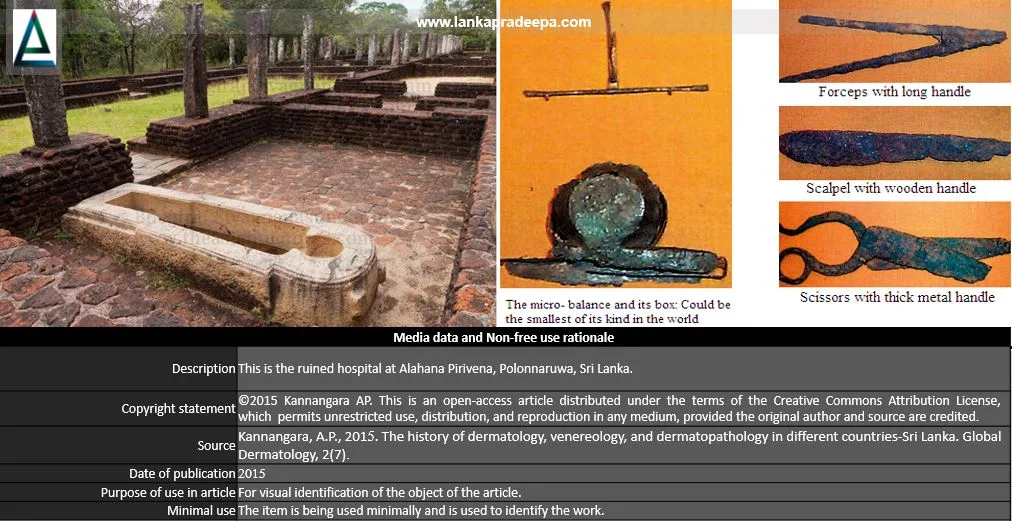
|
Polonnaruwa Ancient Hospital Complex |
The ruins of an Ancient Hospital Complex (Sinhala: පොළොන්නරුව පුරාණ රෝහල) are identified on the premises of Polonnaruwa Old City in Polonnaruwa District, Sri Lanka.
History
Cultural Triangle excavations carried out in 1982/3 confirmed that these ruins situated in the Alahana Pirivena premises are the remains of an ancient hospital complex of the 12th century (Kannangara, 2016; Mueller-Dietz, 1996; Prematileke, 1990). The construction of this hospital is generally attributed to King Parakramabahu I [(1153-1186 A.D.) Kannangara, 2016].
Excavations carried out at this site have unearthed some surgical and medical instruments such as probes, forceps, scissors, scalpels, lancets, herb grinding stones, a micro-balance, a spoon, and storage jars of Chinese celedon used at the time (Jayasuriya, 2016; Wikramagamage, 2004). Some of these artefacts are presently on the display in Colombo National Museum.
The Hospital Building
The rectangular hospital building (25.75 m x 16.65 m) more or less follows the Mihintale Hospital (9th century) prototype in having two distinct units built together, namely living quarters and treatment sections (Jayasuriya, 2016; Prematileke, 1990). The living quarters are formed of cells built around an open courtyard at the centre. At the northern side of the courtyard is a cluster of short stone stumps probably the remains of a shrine built on pillars (Prematileke, 1990). The treatment section is located south of the living area and it also contains a central courtyard (Prematileke, 1990).
The medicinal trough (Beheth Oruwa)
A stone medicinal trough similar to a sarcophagus is found in one of the rooms of this building. Hewn from a monolith, it has a cut-out shape of a man measuring 1.95 m in length (Prematileke, 1990). It has been used for treating patients by immersing in medicinal oil (Jayasuriya, 2016).

Related Posts
Read Also
References
Books, Journal Articles
1) Jayasuriya, E., 2016. A guide to the Cultural Triangle of Sri Lanka. Central Cultural Fund. ISBN: 978-955-613-312-7. pp.80-81.
2) Kannangara, A.P., 2016. The history of dermatology, venereology, and dermatopathology in different countries-Sri Lanka. Global Dermatology, 2(7).
3) Mueller-Dietz, H.E., 1996. Stone „Sarcophagi” and Ancient Hospitals in Sri Lanka. Medizinhistorisches Journal, (H. 1/2), pp.49-65.
4) Prematileke, L., 1990. The architecture of the Polonnaruwa period 800-1200 A.D. Wijesekara, N. (Editor in chief). Archaeological Department centenary (1890-1990): Commemorative series: Volume III: Architecture. Department of Archaeology (Sri Lanka). p.54.
5) Wikramagamage, C., 2004. Heritage of Rajarata: Major natural, cultural, and historic sites. Colombo. Central Bank of Sri Lanka. pp.218-219.


